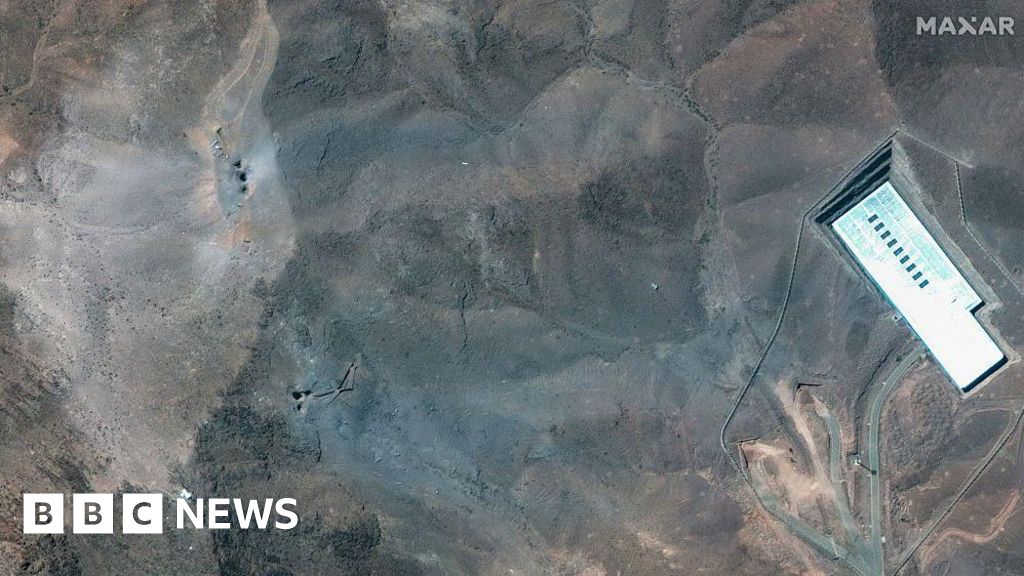The US strikes on Iran's nuclear facilities did not destroy the country's nuclear programme and probably only set it back by months, according to a Pentagon intelligence assessment. The Islamic Republic's stockpile of enriched uranium was not eliminated in the bombings, sources familiar with an evaluation by the Defense Intelligence Agency told the BBC's US partner CBS. The White House said the initial damage assessment was "flat-out wrong" and "a clear attempt to demean" President Donald Trump. The president has said Saturday's air strikes "completely and totally obliterated" Iran's nuclear enrichment facilities. The US struck three nuclear facilities in Iran - Fordo, Natanz and Isfahan - with "bunker buster" bombs capable of penetrating 18m (60ft) of concrete or 61m (200ft) of earth before exploding. But sources familiar with the Pentagon's intelligence assessment say Iran's centrifuges are largely "intact" and the impact was limited to aboveground structures. Entrances to two nuclear facilities were sealed off, and some infrastructure was destroyed or damaged. The anonymous sources told US media it is estimated the attack only set Iran back "a few months, tops", and that any resumption of its nuclear programme may be based on how long it takes the country to dig out and make repairs. Sources also confirmed to CBS that some of Iran's enriched uranium stockpile was moved before the strikes, according to the intelligence assessment. The US 30,000lb (14,000kg) Massive Ordnance Penetrator bomb was thought to be the only weapon capable of destroying Iran's underground nuclear enrichment facilities. More to come.
US strikes did not destroy Iran nuclear programme, says Pentagon assessment
TruthLens AI Suggested Headline:
"Pentagon Report Indicates US Strikes on Iran Did Not Dismantle Nuclear Program"
TruthLens AI Summary
A recent Pentagon intelligence assessment reveals that the U.S. airstrikes on Iran's nuclear facilities did not achieve their intended goal of completely dismantling the country's nuclear program. According to sources familiar with the evaluation by the Defense Intelligence Agency, the strikes, which targeted key sites including Fordo, Natanz, and Isfahan, only managed to delay Iran's nuclear capabilities by a few months at most. The assessment indicates that rather than destroying the nuclear program, the strikes primarily affected aboveground structures, leaving many of Iran's centrifuges largely intact. The U.S. military employed advanced bunker-buster bombs capable of penetrating significant depths of concrete and earth, yet the overall impact on Iran's enriched uranium stockpile was minimal. Reports suggest that some of this stockpile had been moved prior to the strikes, further complicating the assessment of the operation's effectiveness.
In response to the Pentagon's findings, the White House has strongly disputed the initial damage assessment, labeling it as incorrect and politically motivated. President Donald Trump had previously claimed that the airstrikes had “completely and totally obliterated” Iran's nuclear enrichment facilities, a statement that has been called into question by the intelligence assessment. The U.S. government is now faced with the challenge of addressing the implications of these strikes, particularly in light of Iran's potential to quickly resume its nuclear activities depending on how long it takes to repair the damaged facilities. As the situation develops, further analysis and updates regarding the state of Iran's nuclear program and the geopolitical ramifications of the U.S. strikes are anticipated.
TruthLens AI Analysis
You need to be a member to generate the AI analysis for this article.
Log In to Generate AnalysisNot a member yet? Register for free.
